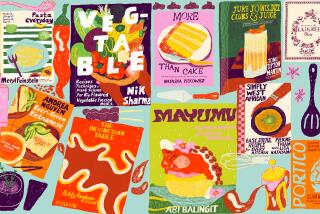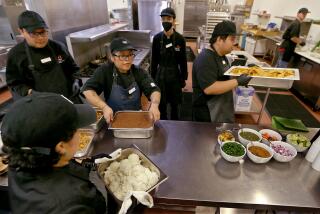Cooking at the Bottom of the World
- Share via
S outh Pole; South Pole; South Pole.
The radio call from a remote field camp on the polar plateau crackles on the short wave band across Antarctica.
This is AGO-4 calling for Sally in the galley.
Overheard on the flight deck of a cargo plane flying across the East Antarctic Ice Sheet in January, the radio call could be a distress signal from scientists marooned by blizzard winds. It could be a routine radio check, part of the daily discipline of field work on the world’s highest, coldest and most isolated continent.
It is an order for takeout.
In the frigid heart of the Antarctic, the South Pole has the only open kitchen for almost a million square miles--the galley of the U.S. Amundsen-Scott Station.
Sally in the galley is the unofficial call sign for Sally Ayotte, a 36-year-old diminutive dietitian from Denver who oversees the 11 sous-chefs, prep cooks, production cooks and bakers in this kitchen at the end of the world.
The radio call comes again.
The researchers at AGO-4 announce they will be flying into the South Pole at midnight to refuel for the long flight to the main National Science Foundation base at McMurdo on Antarctica’s coast. Could they have some dinner brought out to the plane while it idled on the snow runway? And something vegetarian for the field worker who doesn’t eat meat?
Oh, yes, and chocolate chip cookies for the pilot, please.
“Treats for the plane; that’s essential,” says Sally in the galley. “We are famous for our cookies all over the continent. In the summer, we bake 40 dozen cookies a day and they eat them, oh my.”
For Ayotte, food service supervisor at the National Science Foundation’s South Pole station, a chef’s toque blanche is part of the standard government issue of extreme cold weather gear along with a red Snow Goose parka and expedition-weight long underwear.
The Earth may rotate on the axis of the geographic South Pole, where the world’s lines of longitude meet. But the South Pole station revolves largely around food.
At the height of the annual research season from November to March, Ayotte cooks for 240 people engaged in research and operations at the world’s most remote permanent human outpost.
People here may be allowed to shower for only two minutes twice a week but they are served four meals every 24 hours.
The quality of food in Antarctica can be as variable as the weather, ranging from subsistence fare to the sublime.
In a temporary survival shelter on the sea ice in McMurdo Sound, dinner can be little more than a sludge of freeze-dried rice and beans stirred into snow melted over a tiny whisper-jet camp stove. But not so many miles away, it might be a moist turkey perfectly cooked over a steaming volcanic fumarole in an ice cave near the snowy summit of Mount Erebus, the southernmost active volcano in the world.
Dinner in the Amundsen-Scott Station at the South Pole might feature Ayotte’s homemade peach salsa on delicately grilled whitefish, with six kinds of freshly baked pastry, cakes and pie for dessert. Or it might be 80 pizzas made to order from scratch.
“There is not a lot of recreation here,” Ayotte explains. “We eat. We eat all the time. And it has to be good. Food is the most important morale factor. Some people eat four times a day.”
*
The South Pole galley is located under the station’s blue geodesic dome at the end of a tunnel in the snow, inside a portable trailer insulated like a meat locker. Other bunkers house living quarters, offices, a sick bay and a library.
Crates of frozen turkey breasts, fish filets, pizza dough, vegetables and other foodstuffs crowd the spaces between the bunkers and the inside wall of the dome.
In the dining room, people eat in shifts. There are seven tables, each seating nine people. A string of Christmas lights runs along one wall. There are wall pegs for parkas and a stainless steel freezer full of leftovers, three kinds of cookies, baklava and fresh cherry turnovers for the taking.
The galley itself is a cramped alley that runs parallel to the dining room. It holds two stoves, two convection ovens and two conventional ovens. There is an electric grill, a deep fryer, a flattop grill and never enough counter space.
“There is not enough elbow room. There is not enough refrigerator space. There is not enough anything,” Ayotte says.
There is at least no shortage of freezer space.
Ayotte has the world’s largest icecap--an expanse of ice two miles thick and almost half again as large as North America--at her disposal. The mean temperature during the busy research season is 56 degrees below zero.
At the South Pole, the normal air pressure equals an altitude of about 11,600 feet. Water boils at about 200 degrees Fahrenheit--about 12 degrees below normal.
Cooking begins where high altitude cookbooks leave off.
The lower air pressure and extreme aridity also alter how many ingredients react. There is so little oxygen in the air--about 60% of the normal concentration at sea level--that the fats in food are not properly metabolized by the human body.
Baking powder, yeast, sugar and butter all behave differently than they do at sea level. Some expand too rapidly in the low air pressure; others become over-concentrated as liquids evaporate too quickly.
The result is cakes expand too rapidly and fall. Batter will refuse to set or overflow its pan.
The ovens misbehave because the heat does not circulate evenly in the low air pressure. A watched pot can boil dry and still not cook the beans. The cooking time for casseroles must be recalculated and roasting times adjusted by trial and error.
Even the air bubbles in bread have a mind of their own.
“I always tell the new baker the first week to not bother making muffins,” Ayotte says. “Pasta can be a great challenge for a first-time cook at Pole.”
To plan the menu properly, Ayotte must think ahead.
It takes four days for frozen food to thaw. And almost a week before a five-gallon jug of dish soap can be warmed enough to raise suds.
Groceries are delivered once a year from Port Hueneme, north of Los Angeles.
Her standard order includes 13,000 pounds of beef, 9,000 pounds of pork, 10,000 pounds of chicken and 3,500 pounds of seafood. There are 800 dozen tortillas on the shopping list, along with 575 pounds of peanut butter, 700 pounds of tofu, 500 half-gallon containers of ice cream and, of course, 500 pounds of chocolate chips for the cookies.
It all crosses the Southern Ocean to McMurdo in 48 refrigerated containers loaded aboard a freighter at Port Hueneme’s Wharf 3, tucked between a helicopter repair ship and a warehouse storing the wreckage of Alaska Airlines Flight 261.
From McMurdo, supplies are ferried by ski-equipped cargo planes 838 miles to the South Pole station.
Fresh vegetables are flown 3,000 miles once a month from New Zealand, weather permitting. It often does not.
Inside the station dome, however, there is a small hydroponic greenhouse that yields enough lettuce, chives, cucumbers, parsley, peppers, tomatoes, dill and basil under full spectrum lights to make a monthly salad for the station crew.
“Lots of people come up into the greenhouse to just sit and smell the green,” Ayotte says. “It is a great place to forget where you are.”
Despite the most meticulous planning, early expeditions often were a race against malnutrition. The best meals were those served up by overactive imaginations.
*
“Dreams as a rule [are] of splendid food, ball suppers, sirloins of beef, caldrons full of steaming vegetables,” polar explorer E.A. Wilson noted in his diary during a 1902 foray into Antarctica’s bleak interior. “But one spends all one’s time shouting at waiters who won’t bring one a plate of anything, or else one finds the beef is only ashes when one gets it.”
His actual Christmas feast was seal liver fried in bacon and lard along with a large spoonful of jam.
In their drive to be first at the South Pole, the ill-fated 1911 expedition led by British explorer Robert Falcon Scott subsisted on biscuits, butter, cocoa, tea and a mixture of beef and lard called pemmican. On the final leg of the trek, Wilson and the others in Scott’s party were allocated a ration of 4,430 calories a day.
By comparison, a healthy male doing manual work in more temperate climate requires about 3,600 calories a day.
But construction workers assembling the new South Pole station today routinely consume about 5,000 calories a day--and some of them still lose weight laboring in such extremes of cold and altitude.
For the hundreds of miles of hard trudging by Scott and his men, the daily ration may have been 1,000 calories too low, according to polar historian Roland Huntford.
Scott’s field fare also was so low in key nutrients that it failed to satisfy the minimum daily requirements of vitamin B (thiamine), vitamin B2 (riboflavin) and nicotinic acid. The rations also lacked any source of vitamin C. That left the expedition at risk of scurvy, beriberi and pellagra.
Certainly, such vitamin deficiencies also could contribute to depression, retard the healing of injuries and heighten susceptibility to cold. Some historians argue that Scott and his men essentially starved to death on their last polar trek.
The successful South Pole expedition led by Roald Amundsen, who beat Scott to the Pole by a month, relied on a menu that was not so different in some ways--pemmican, chocolate, dried milk and biscuits. They too lacked vitamin C.
But the biscuits each expedition carried were baked differently and that was a crucial difference.
Those used for Scott’s ration were made with white flour with sodium bicarbonate used for leavening. Amundsen’s were baked with whole meal flour and rolled oats, while yeast was used as leavening. The yeast and whole grains are rich in vitamin B.
Even so, when Amundsen and his party arrived at the Pole, the sled dogs were so ravenous they tried to eat their harnesses.
Bad food is almost an Antarctic tradition.
Early explorers supplemented their tinned meat extract and dehydrated vegetables with fresh seal and penguin. The English adventurer Sir Francis Drake boasted of killing 3,000 penguins in a day to fill his fleet’s larder as he ventured into Antarctic waters near the tip of South America for the first time.
Even starvation and scurvy could not improve the flavor of penguin meat.
In 1897, the ship’s surgeon of the Belgica expressed his disdain for penguin dinners as the ship drifted for months locked in the grip of the sea ice: “If it is possible to imagine a piece of beef, odiferous cod fish and a canvas-back duck roasted together in a pot, with blood and cod-liver oil for sauce, the illustration would be complete”.
Perhaps it was an acquired taste. “Galantine of seal and penguin in aspic are not to be despised,” noted Scott’s meteorologist George Simpson.
*
No one is allowed to even touch a penguin in Antarctica today under terms of an international treaty that protects all the wildlife on the continent.
Today, even the most remote field camp has its own dedicated cook and a surprisingly well-stocked larder.
Danielli Spears, a 29-year-old cook from Estes Park, Colo., set up a kitchen for 20 scientists earlier this year in a blue survival shelter at Vostok on the East Antarctic Ice Sheet, officially the coldest spot on Earth.
A ski-equipped LC-130 cargo plane delivered her and 40 crates of frozen food to the isolated expanse of ice in December. The austral summer temperatures hovered at minus 33 degrees Fahrenheit.
She brought a high-altitude cookbook with her but found it left off at 7,000 feet. The pressure altitude at Vostok was about 13,000 feet and water boiled at 189 degrees--23 degrees below normal.
For 38 days, she improvised.
She served up Cornish game hens and Alaska king crab legs. She baked loaves of apricot nut bread. She grilled T-bone steaks and barbecued shrimp on bamboo skewers. She served fresh vegetables every day.
For Christmas dinner, she roasted two turkeys with a corn bread and sausage stuffing. There were baked yams and real mashed potatoes. She even whipped up eggnog.
“Altitude plus the cold really burns the calories. I lost five pounds and I was eating tons of food,” Spears said.
“We called our camp the high-altitude weight-loss clinic.”
SH South Pole Specials
Active Work Time: 20 minutes * Total Preparation Time: 1 1/2 hours
*
1/2 cup (1 stick) margarine
1/2 cup (1 stick) butter
3/4 cup brown sugar, packed
3/4 cup granulated sugar
2 eggs
2 teaspoons vanilla extract
2 1/2 cups flour
1 teaspoon baking soda
1/2 teaspoon salt
2/3 cup chocolate chips
2/3 cup white chocolate chips
2/3 cup butterscotch chips
1 cup nuts, chopped
Heat the oven to 375 degrees.
Cream the margarine and butter with the brown and granulated sugars. Add the eggs and vanilla and beat until fluffy.
In a separate bowl, combine the flour, baking soda and salt and add to the creamed mixture. Stir in the chocolate, white and butterscotch chips along with the nuts.
Drop rounded spoonfuls of batter 2 inches apart onto a baking sheet. Bake the cookies until they’re pale golden brown, 12 to 14 minutes.
*
About 48 cookies. Each cookie: 143 calories; 103 mg sodium; 14 mg cholesterol; 8 grams fat; 3 grams saturated fat; 17 grams carbohydrates; 2 grams protein; 0.51 gram fiber.
More to Read
Sign up for Essential California
The most important California stories and recommendations in your inbox every morning.
You may occasionally receive promotional content from the Los Angeles Times.










